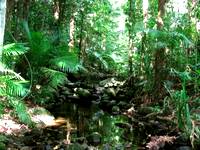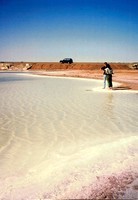Australian Climate And Weather
"Australia is a very big country with
many different climate zones."
The Australian climate and the Australian weather are the subject of many questions from travellers:
- What is the best time to visit Australia?
- What is the climate in the Outback?
- How is the weather in Australia?
- How warm/cold will it be in Australia on my vacation?

This road sign really exists, and so do the penguins.
The Australian weather and the temperatures at the time of your visit depend on where in Australia you want to go.
(If you haven't decided yet explore this site further. It's there to help you with that decision.)
Australia is a very big country with many different climate zones.
To see what I mean and to get a quick overview look at this map of Australian climate zones. (Or this one which has even more detail.)
The map is based on temperature and humidity to show you, the tourist, how comfortable you will be.
Seasons | Deserts | East Coast | South West | Tasmania
Four Seasons - Tropical Seasons
The seasons in Australia are opposite to those in the Northern hemisphere. That means we have Christmas in mid summer. After years of living here it still feels very strange...
Only the southern parts of Australia show the distinct four seasons as they are known in Europe and North America.

One third of Australia lies above the Tropic of Capricorn.
In the North the weather is warm or hot all year round. The tropics have only two seasons: A warm dry season (May - October) and a hot wet season (November - April).
For the advantages and disadvantages of travel in the North at different times of the year see this page in the Kakadu National Park section.
Australian Climate - Deserts
In arid inland Australia - commonly known as the Outback and in the map shown as zones with hot, dry summers - the differences between day and night temperatures and also between summer and winter are a lot bigger than along the coasts.
The heat is not as oppressive as it is when combined with humidity. A hot and dry day is a lot more comfortable than a warm and very humid day. Don't forget to drink though! You will lose a lot of moisture without even noticing.

The nights can be very cold!
Australian weather in the desert is very unpredictable. It might not rain for years. At other times torrential downpours can cause widespread flooding and fill the usually dry inland salt "lakes" like Lake Eyre.
To see the Outback desert explode into life after rain is a truly magical experience. A carpet of wildflowers appears over night and frantically breeding animals will make the most out of the precious moisture and abundance of food while it lasts.
I also write about the desert Outback climate on this page.
Australian Climate - East coast and South East
The warm waters of the oceans moderate the climate in the coastal areas which don't experience high or low temperature extremes. The weather gets generally warmer as you go further north, or milder if you turn south. These are the most densely populated areas of Australia, and here you will find the most tourists.

The drastic change in climate as you move away from the coast is due to the Great Divide.
A mountain range running north to south with peaks over 2000 m high separates the coast from the inland regions. On the western side rainfall is low. The land flattens into the vast inland plains and temperatures become more extreme again.
Australian Climate - South and South West

The weather in these regions is best described as Mediterranean. Long dry summers followed by mild and rainy winters. The southern coasts can experience very cold weather in winter. There is nothing to stop a wind that comes blowing from Antarctica...
Australian Climate - Tasmania
In one word: cold.
Ok, that is coming from someone who lives at the other end of the continent. Tasmania's climate is very temperate. The yearly range of the daily temperatures on the coast is only about seven degrees. It rises as you move inland, but no part of Tasmania is further than 115 km from the coast.
Summers are very mild. The east coast is warmer than the wetter west coast, and winter inland temperatures can drop well below zero.
Find more Australian climate information and Australia Facts
Return from Australian Weather to Outback Australia Travel Guide home page





